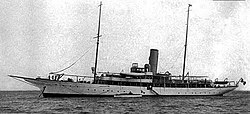Elettra (ship, 1904)
|
Elettra around 1925
|
||||||||||||||||||
|
||||||||||||||||||
|
||||||||||||||||||
|
||||||||||||||||||
|
||||||||||||||||||
|
||||||||||||||||||
Elettra was the name of the research vessel with which Guglielmo Marconi carried out scientific experiments on radio waves and radio transmissions from 1919 to 1936. The yacht was launched in 1904 and wasin Austrian serviceuntil 1919 under the name Rovenska .
history
Archduke Karl Stephan of Austria ordered a yacht from Ramage & Ferguson at the beginning of the 20th century, which was launched on March 27, 1904 and was christened by his wife Maria Theresia Rovenska . The name was reminiscent of the place of the same name Rovenska on the island of Lošinj , where Karl Stephan of Austria had his winter residence. In 1910 the yacht was sold to the British businessman Max Waechter . In 1914 the industrialist Gustav HF Pratt bought it. After the outbreak of World War I , the Royal Navy bought the ship. The ship was armed and now served as a patrol boat and escort ship between Brest and Saint-Malo . After the armament was removed in Southampton , the ship was auctioned in 1919. An English lord bought the ship and shortly afterwards sold it to Guglielmo Marconi for £ 21,000 .
In July 1919, the Rovenska left England and reached Naples in August of the same year . In the shipyard in La Spezia she was equipped for future use. On October 27, 1921, the Elettra , as the ship was now called, was registered in the Italian shipping register and registered with the number 956 on December 21. On July 30, 1934, Guglielmo Marconi demonstrated in the Gulf of Tigullio how to navigate a ship without sight and using microwaves . For this purpose, the view was blocked with curtains in the Elettra's cockpit . Now he steered the ship guided by a radio signal from the beacon, which was later called Torre Marconi, between two buoys in front of the port of Sestri Levante . On March 26, 1930, Marconi switched on 3000 lightbulbs by radio on board his ship, which was moored in La Spezia, in Sydney , 16,000 km away, on the occasion of an electronics and radio exhibition. On August 12, 1930 fire broke out as a result of a short circuit on the Elettra , but it was extinguished after a short time.
After Marconi's death in 1937, the Elettra was bought by the Italian Ministry of Communications for 820,000 lire . When the war broke out, the ship was moved to Trieste . After cease of Cassibile the vessel was from the Navy acquired with a 15 mm automatic cannon equipped and two 20-mm twin guns and when G 107 placed at the service of the 1st Geleitflottille. It was later renamed NA 6 . On December 28, 1943, the ship left Trieste for a patrol mission. On January 21, 1944, she was discovered by enemy fighter bombers near Zadar and sunk.
After the war, the wreck became the property of Yugoslavia . Italy planned to lift and repair the ship. Only in 1959 did Yugoslavia allow the wreck of the Elettra to be examined and, after difficult negotiations, the recovery was finally allowed, which took place in 1962. The ship was brought to the Arsenal in Venice . In 1972 the restoration project was abandoned and in 1977 the ship was dismantled into parts. Most of the parts were brought to the Maritime Museum in Trieste. The technical equipment is exhibited in the Museo nazionale della scienza e della tecnologia Leonardo da Vinci in Milan . Other parts are in the Museo tecnico navale in La Spezia and in the Museum Marconi in the Villa Griffone .
Web links
- La Nave Laboratorio "Yacht Elettra"
- Elettra
- Marconi's yacht "Elettra" / IBDK
- Escort Flotilla Adria 1944–1945
literature
- Riccardo Magrini: Ships. Sailing ships, warships, passenger and merchant ships , Fränkisch-Crumbach 2016, p. 176, ISBN 978-3-8468-0022-5
- Maria Cristina Marconi: Marconi My Beloved , Boston 2001, ISBN 0-937832-36-7 [1]

